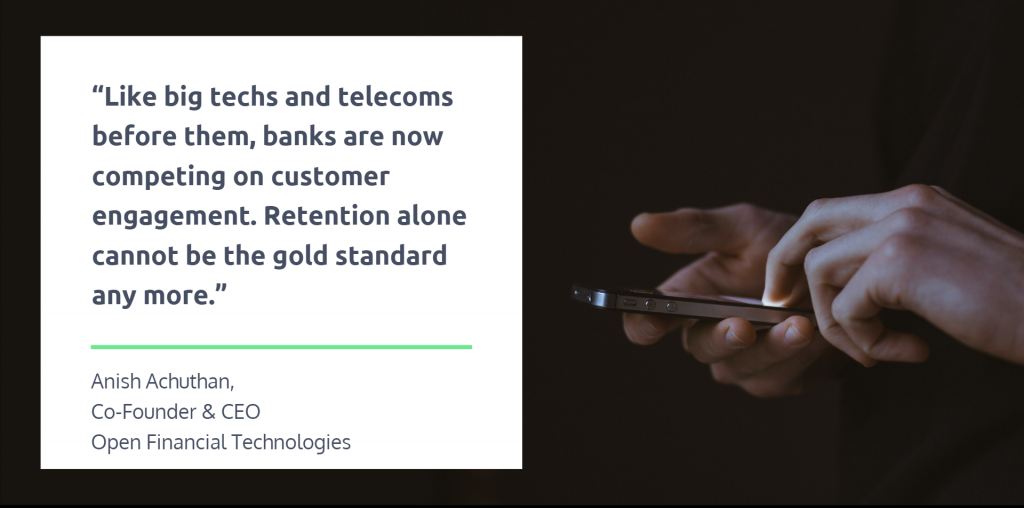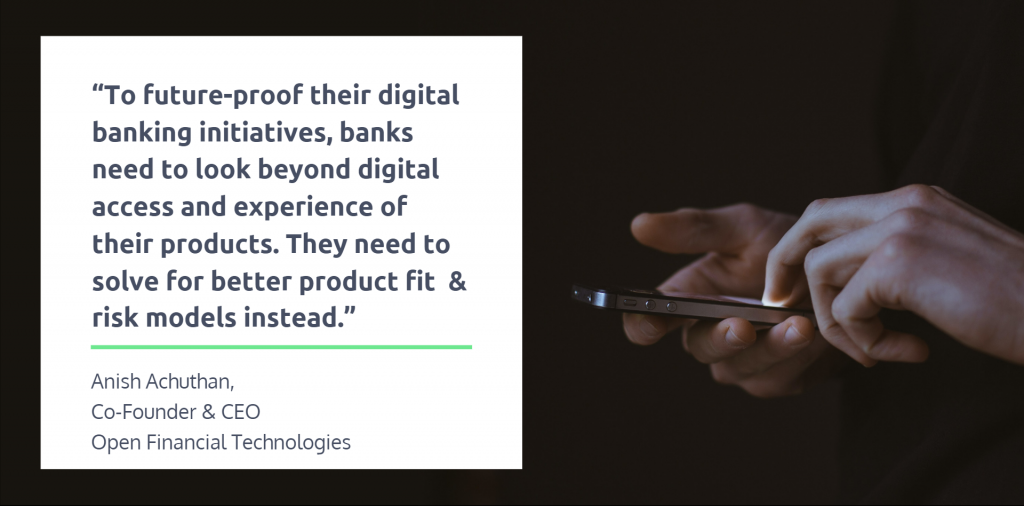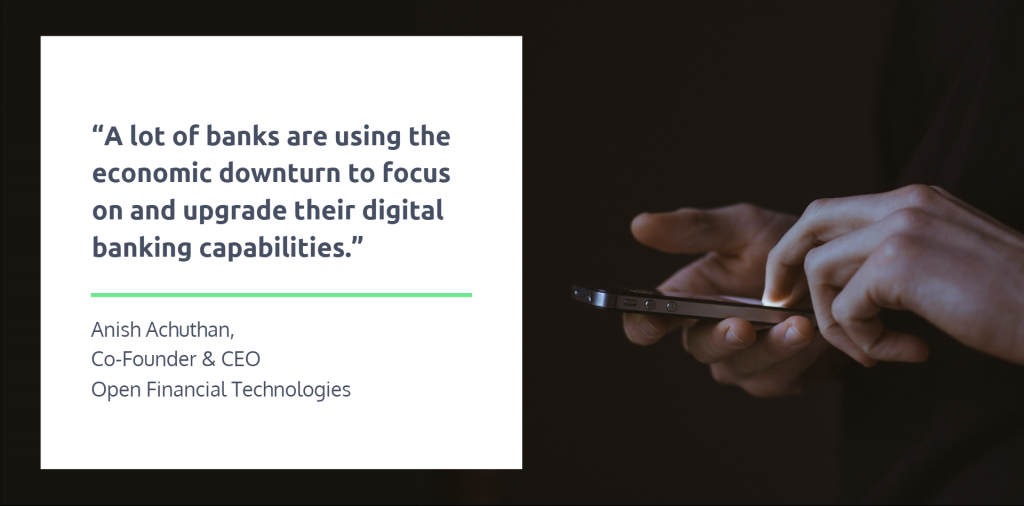Modern digital banking models can add up to 4% in annual revenues – that’s close to half a trillion dollars in additional revenue – for banks by 2025.1
Financial technology is growing the pie of traditional banking revenues. From developing targeted, efficient products to serve niche customer segments, to opening up new business models that position banks as trusted curators and aggregators in an increasingly fragmented market, fintech is changing the entire conversation around why, and how, banks should transform.
For example, in an open letter to shareholders, Jamie Dimon, Chairman and CEO of JPMorgan Chase highlighted the strategic, long term investments they are making to address the changing dynamics in banking2. While he called ‘digital account opening for consumers and small businesses’ table stakes, he spoke about business models like embedded banking and API banking as focus areas, along with AI-led prospecting and profiling capabilities for their commercial banking business.
N26, headquartered in Germany, runs a subscription-fees based model, wherein a free online bank account is bundled with several value-added products and services around personal finance, payments, cards, insurance and lending. By partnering with select financial marketplaces for some of these products and services, N26 enhances its customers’ choices, while also increasing its own revenues by ensuring that the transactions take place on its platform.
Essentially, like big techs and telecom providers before them, banks and financial institutions are now competing for customer engagement. Customer retention, as a metric, can no longer be the gold standard, as customers may maintain accounts with banks, but go to alternative providers for their payments, cards, insurance, and lending needs.
In the words of Max Chuard, CEO, Temenos, “Up to 20% of banking revenues could shift to new players by 2025.”

Banks understand and acknowledge these shifts. Importantly, most banks also recognise that capex-intensive, multi-year projects to build fintech solutions in-house will not deliver the agility they need to launch, test and enhance modern digital banking solutions. BANKINGSTACK is our vision to deliver innovative, targeted and market-ready digital banking solutions in the form of a cloud-native fintech operating system. With a best-in-class neobanking engine, segment-specific solutions, and value adding ecosystem partnerships, the BANKINGSTACK OS helps banks and FIs launch modern digital banking solutions in a matter of weeks.
Future-proof digital banking
One-size-fits-all products and digital experience, inefficient and expensive acquisition, and opaque credit assessment models have all become flashpoints for customer engagement in incumbent banks. Product fit has especially come into focus after the entry of neobanks catering to specific segments like small and medium businesses (SMBs), start-ups, freelancers, etc.
SMBs represent close to a fifth of the total global banking revenues, and this segment is expected to grow by 7 to 10 percent annually, over the next 5 years.3
Fintechs were able to identify several white spaces in this segment, which has traditionally found it difficult to open bank accounts, establish a credit record and get loans. By bundling financial automation capabilities and value added services across accounts, bookkeeping, cards, expense management and lending, neobanks are offering holistic ‘run-the-business’ and ‘grow-the-business’ solutions for SMBs.
For example, US-based Chime offers a special Credit Builder account targeted at thin-filed SMBs and start-ups who need to build a positive FICO score, while also accessing timely credit. Open Money, our flagship platform, offers complete procure-to-pay and order-to-book automation, making it possible for SMBs to execute e-invoicing and file goods and services tax (GST) directly from their business account dashboard. Most neobanks also bundle extensive expense management capabilities along with corporate cards issuance to help entrepreneurs control spend and prevent fraud.
Being able to participate in alternative lending markets is another significant white space for banks.
The global revenue-based financing (RBF) market alone is expected to exceed USD 42.34 billion by 2027, growing at 6.1 percent CAGR.4
By integrating and automating workflows across banking, finance and operations, fintechs have set the framework for alternate risk assessment models. With innovative underwriting based on access to a business’ cash flow, receivables, orders, deliveries, and operational spend, banks can now look at scaling their low-risk lending portfolios to previously unaddressed segments.
Thus, to effectively future-proof their digital banking initiatives, banks need to look beyond access and experience of their digital products. Adding new mobile banking features or a new distribution channel is not a long-term solution. Instead, banks need to solve for acquisition of niche customer segments, better product fit, and the ability to finance at low risk using alternative risk assessment models.

Accelerating innovation & outcomes
The vision for BANKINGSTACK started out as a white-labelled version of our biggest success, the Open Money neobank platform. Having achieved milestones like 2.5 million SMEs onboard and transactions worth USD 30 billion, the platform had generated enough curiosity and credibility for our business model and product fit.
Over several knowledge-sharing conversations with banks, I further understood that banks are looking for rapid, low-capex adoption, fast go-to-market, and continuous delivery of ongoing innovations and enhancements. This is what finally helped us architect our solution as a cloud-native fintech operating system comprising:
- A foundational platform comprising our neobanking engine, with capabilities across accounts, bookkeeping, payments, lending, expense management and cards
- Solution packs (SME, D2C, Freelancers, Students, Young Professionals, etc.) comprising segment-specific products, services and workflows controlling the entire customer experience
- No-code, low-code and full stack embedded finance capabilities to help banks explore banking-as-a-service (BaaS) opportunities
As a ‘stackable’ solution, the BANKINGSTACK OS does not replace existing digital banking infrastructure, but complements and enhances it with new workflows and underwriting capabilities. This reduces capex, disruption, and adoption time significantly, making it easier for banks to experiment and adopt modern digital banking solutions.
Digital banking has an exciting roadmap
Even as we have started strong with 14+ banks across India and South East Asia, the roadmap for further developments in BANKINGSTACK already feels urgent. From extensive trade finance capabilities to cross-border payments, we are hearing of several specific solutions that banks want to focus on in the coming year or two. I also see the current economic downturn playing a role; a lot of banks are using this time to focus on building capabilities and positioning themselves correctly for when the market picks up again.

What does your roadmap to digital banking success look like? We’d love to hear from you, and understand how we can help.
References:






